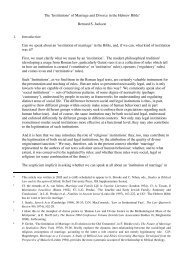Here - Deborah Charles Publications
Here - Deborah Charles Publications
Here - Deborah Charles Publications
You also want an ePaper? Increase the reach of your titles
YUMPU automatically turns print PDFs into web optimized ePapers that Google loves.
- 44 –so the land may be turned over to the Arabs is in the category of an ‘informer’” and subject, according to Maimonides as read byRabbi Ariel, to being destroyed and consigned to hell.” One who is able to help the settlers and fails to do so “is accursed,” andaccording to the halakhic sources, as he reads them, it is permissible, as a matter of Torah law, to protect one’s property and“prevent the entry of someone breaking into one’s home by using even mortal force.”These ideas clearly express an approach that presents itself as exclusively halakhic, utterly divorced from the discourse ofUnity of Opposites. It makes no effort to incorporate the opposing positions and certainly not to find any reason, or virtue in them.Rabbi Ariel’s statements are a matter of theory, but the ideas have been translated into action in a social phenomenontaking shape “on the mountains of Samaria". I am referring to the group calling themselves Price Tag. I see a deep affinity, as amatter of political theory, between the Price Tag activists and Torat ha-melekh. Let me briefly describe it."Price tag" began its operations in 2008, conducting acts of violence—usually reactive—against Palestinians. These actshave included stoning, burning fields, cutting trees, damaging mosques; in addition, there has been violence against IDF propertyand its soldiers. Price Tag’s operations have been carried out by hundreds of activists and passively supported by a few thousandsmore.The logic behind Price Tag took shape in the wake of the failure to prevent the abandonment of Gush Qatif and Amonaand the ensuing despair. The premise that “we will prevail though love” (a technical and functional, if not cynical and aggressivepolitical translation of Unity of Opposites) came to be seen as flawed. At the same time, there was a loss of confidence in all otherforms of political or settlement action. The sense was that the political instrumentalities on the one hand and the theoretical-utopiantools on the other had proven useless. The Unity of Opposites dialectic having failed with respect to relations between secular andreligious Zionists, the Price Tag people adopted, instead, a dichotomous approach. As they saw it, it was necessary to widen thegap between the two sides, making it into a chasm between “light and darkness” and “left and right.” These forces would no longerbe allowed to intermingle, and no efforts whatsoever would be made to find virtue in the Other. All one’s resources should bebrought to bear on the direct confrontation. The conflict was to produce two sorts of de-terrence—one against the institutions ofthe State and the other against the Palestinians. The threat of violence on the part of settlers would make the State more carefulabout requiring evacuations of settlements, and the Palestinians would come to see that the Jews in the settlements would respondin kind to violence. The approach abandons any interest in maintaining dialogue or building bridges; it leaves no room forsensitivity to situations that might be seen to involve “a desecration of God’s Name”; and it casts aside belief in the possibility andbenefit of inclusiveness. On the contrary: it believes in using violence to generate conflicts and clashes. Paradoxically, the PriceTag people see these clashes as empowering. As opposition to them intensifies and criticism becomes more extreme, they believe,more and more people within Religious Zionist circles will come to identify with them and join their ranks, as they are put off bythe criticism leveled against them.A year after the start of Price Tag activities, Torat ha-melekh was published. It produced a public impact previously seenonly in the wake of the publication of Barukh ha-gever, a book responding to the furious reaction to Barukh Goldstein’s massacreof Muslim worshippers at the Makhpelah Cave in Hebron. Barukh ha-gever endorsed Goldstein’s actions and even consideredthem to be praise worthy; but it lacked the halakhic gravitas of the later work here under consideration.Torat ha-melekh is the first volume in a series now being produced, 5 and it positions itself as an exclusively halakhicwork. Its two authors teach at the Od Yosef Hai yeshiva in Yizhar, and consider themselves students of Rabbi Isaac Ginsburg(president of the yeshiva). It is he who also provides the kabbalistic mantle for this halakhic move. It also is worth noting theaffinity between these theories and the political phenomenon embodied in the figure of Rabbi Meir Kahane, on which I will havemore to say later.Torat ha-melekh uses distinctions drawn in the halakhah between Jews and Gentiles and applies them to contemporarycircumstances so as to unleash, in an utterly unparalleled manner, all restraints on the use of force against Gentiles. In theirintroduction, Shapira and Elitsur warn that it is forbidden to kill Gentiles, but their book is devoted to doing the opposite: itexplains when it is permitted and desirable to kill non-Jews; it raises the possibility that there may be no reason to allow non-Jewsto continue to exist in the world (p. 175); and it suggests that it is permissible to kill children in time of war if it is clear that whenthey grow up, they will “harm us.” (In an article written by Rabbi Israel Ariel in support of the book, he approves of such actions.)The book transforms a non-Jew’s life into something having the same value as an animal’s life.The book uses the distinction drawn by Maimonides between the prohibition of murder, which applies only to a Jewishvictim, and that of shedding human blood, which applies to a Gentile. It follows that one who kills a Gentile is not subject tocapital punishment. In light of that distinction, the authors attempt to argue that the lives of non-Jews are considered only from apragmatic and rational perspective, in contrast to Jewish lives, regarding which non-pragmatic considerations related to sanctity oflife come into play. That difference affords the basis for some of the halakhic determinations reached in the book. For example,according to the authors, if a group of gentiles is ordered by an enemy to offer one of their number to be killed so that theremainder of the group will be spared, it is entirely proper to comply with the demand and hand over the person requested in order





